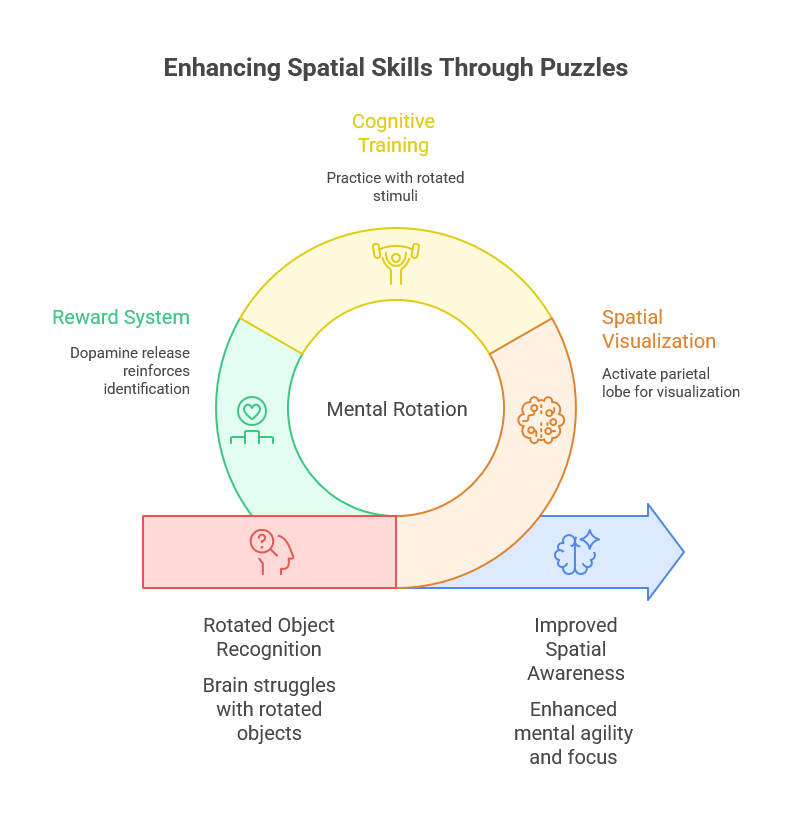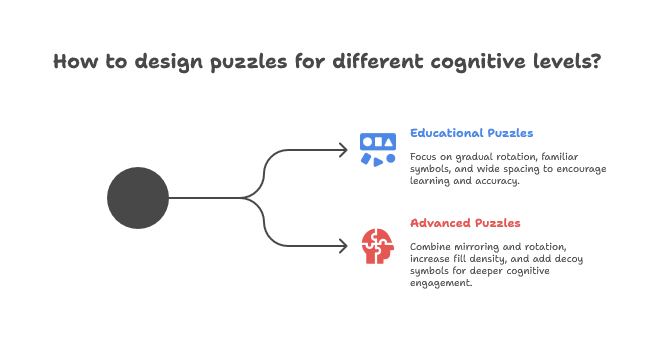Why Mirrored and Rotated Letters Make the Brain Work Harder (and Why That’s Good)
Exploring how orientation challenges in Seek and Find puzzles stimulate focus, visual memory, and cognitive flexibility.
Introduction: When Familiar Becomes Unfamiliar
Have you ever noticed how a single flipped letter or rotated number can completely change how you perceive a puzzle? A simple ‘G’ turned sideways or an upside-down ‘7’ suddenly becomes unrecognizable, even though you know exactly what it is.
That moment of hesitation — the brain’s pause to reorient itself — is what makes these puzzles so powerful. Seek and Find puzzles that use rotated and mirrored symbols challenge players to break automatic recognition patterns, forcing deeper visual processing and sharper concentration.
With Puzzle Maker Pro – Seek and Find, creators can use rotation and mirroring settings to craft puzzles that train the brain while entertaining players of all ages.
The Cognitive Science of Rotation and Recognition

Our brains rely heavily on pattern recognition to process symbols. When we read or identify shapes, the visual cortex quickly matches what we see to stored templates in memory. This process is efficient — until something breaks the pattern.
When a familiar object is rotated or mirrored, the brain has to mentally “turn” or “flip” it back into a recognizable orientation. This extra processing step, called mental rotation, activates areas of the brain associated with spatial reasoning and working memory.
Studies in cognitive psychology show that tasks involving mirrored or rotated stimuli increase activation in the parietal lobe, the region responsible for spatial visualization. This means every time someone solves a rotated Seek and Find puzzle, they’re effectively training their brain in spatial awareness and mental agility.
Why the Challenge Feels So Engaging
We’re wired to enjoy manageable challenges. A Seek and Find puzzle with slightly altered orientations creates a subtle sense of dissonance — enough to engage the solver, but not enough to frustrate them.
That moment of “Wait, is that a 6 or a 9 flipped?” triggers curiosity and persistence. The brain wants to resolve the confusion, and each successful identification delivers a small hit of dopamine, reinforcing the reward cycle.
It’s this balance of effort and reward that makes rotated and mirrored puzzles so addictive. They keep the mind alert, sustain focus, and encourage perseverance — all while feeling like play.
Designing Rotation-Based Challenges

In Puzzle Maker Pro – Seek and Find, rotation and mirroring options give you complete control over puzzle complexity. You can apply rotation in increments (30°, 45°, 60°, or 90°) or combine horizontal and vertical reflections for maximum variation.
For Educational and Developmental Puzzles
- Introduce rotation gradually. Start with one or two rotated symbols per grid.
- Use familiar letters or numbers. Kids learn to adapt faster with content they recognize.
- Keep grid spacing wide. This prevents visual overload while encouraging accuracy.
For Advanced or Adult Puzzles
- Use both mirroring and rotation. Combining these effects forces deeper cognitive engagement.
- Increase fill density. Dense puzzles demand stronger focus and spatial scanning.
- Add decoy symbols. Similar-looking characters (like E and F) test detail recognition.
These design decisions let you fine-tune cognitive load — ensuring each puzzle offers challenge without discouragement.
The Educational Value
Mirrored and rotated puzzles aren’t just entertaining — they have tangible cognitive benefits. They help:
- Improve spatial reasoning: Understanding how orientation affects perception.
- Enhance attention to detail: Discriminating between subtle visual differences.
- Build visual memory: Remembering symbol positions and orientations.
- Develop persistence: Encouraging learners to slow down and verify their perceptions.
In classrooms, teachers can use rotated puzzles to strengthen letter and number recognition. For adults, they double as brain-training exercises that enhance cognitive sharpness and problem-solving ability.
“These puzzles trick your brain into working harder — but in a way that feels rewarding, not exhausting.”
— Cognitive Educator, Visual Literacy Consultant
Why Mirroring Matters
Mirroring adds an entirely new dimension to Seek and Find puzzles. Our brains are not naturally wired to recognize mirror images quickly. A mirrored ‘B’ or ‘K’ feels familiar yet wrong, forcing solvers to inspect every detail.
This inspection builds what psychologists call perceptual discrimination — the ability to tell the difference between similar stimuli. It’s an essential skill in early reading and visual processing.
For adults, mirrored puzzles can be therapeutic. They encourage mindfulness and sustained focus, qualities often associated with stress relief and mental rejuvenation.
Practical Tips for Puzzle Creators

- Start simple, scale up. Begin with single rotation angles before combining them.
- Use high contrast. Ensure symbols remain distinguishable after rotation.
- Balance layout density. Too much clutter can overwhelm the eye and reduce enjoyment.
- Test difficulty. Have players of different skill levels try your puzzle before publishing.
- Offer solutions. Showing how symbols appear in the correct orientation reinforces learning.
Whether for KDP books, educational printables, or mindfulness products, rotation-based puzzles add value through cognitive engagement.
The Therapeutic Side: Puzzles for Focus and Mindfulness
Solving rotated or mirrored puzzles is mentally absorbing. The process engages the brain’s attentional networks while shutting out distractions — similar to meditation or coloring activities.
Many educators and therapists use visual puzzles to help learners or clients focus, calm anxiety, and build resilience. The structured yet creative nature of Seek and Find puzzles makes them perfect for this purpose.
With Puzzle Maker Pro, you can design puzzles that suit therapeutic, educational, or recreational goals — all while maintaining professional quality and variety.
Wrapping Up: A Simple Twist with Powerful Effects
Something as small as turning a symbol upside down can transform an ordinary puzzle into a mental workout. By adjusting orientation, spacing, and density, creators can fine-tune engagement and deliver puzzles that sharpen observation, focus, and confidence.
Whether for children learning to recognize letters or adults looking to challenge their minds, rotated and mirrored Seek and Find puzzles offer endless opportunities for meaningful play.
Ready to give your puzzles a twist?
Explore Puzzle Maker Pro – Seek and Find and start creating puzzles that challenge perception and boost focus today.
